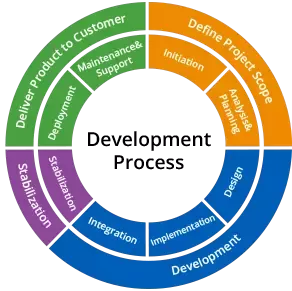Things that comprise the software production
1. Product development lifecycle - This is the one through which software is developed. It helps in giving up an idea on the development steps that include design, testing, conceptualizing, deployment and most importantly planning. In addition to this, the overall development works amazingly well wi0th the help of Agile and Scrum methodologies.
2. Feasibility testing - The main focus in the software development world is to work up with better management of features. This can be achieved with the help of having a perspective on a product that allows us to check it infeasible mode. It allows a prototype to work up as per the requirement and tested whether it is up to the mark or not. In addition to this, it helps in working upon the management to focus on the project while investment, time and effort.
3. Feedback - This helps in the essential factor of product development. Constant feedback helps in improving and updating the production cycle that helps in improvising the factor for the development company. It also helps in keeping things in flow to ensure that the product is handled well with zero to minimal error to it. Also, the companies focus in such a way that allows them to focus on product rollout and maintenance to ensure that the market is wholly conceptualized to ensure that it focuses wraps up all the major concepts. It helps the market to get a hang on rolling out things to keep it well and severely maintained.
4. Marketing Services - Product development has made a huge name in terms of marketing. The main thing that digital media has covered up is marketing for companies. It has made it easy for the companies to market their product with software or some other website mode. This involvement helps in promoting aspect making it easier for business to reach the maximum crowd. It also helps companies to focus on momentum and easily get the sales done for the business. It helps in getting an accurate approach with the desired form to get things done in an accurate flow.
9 Categories of Software
1. Technology Platforms - Amazon Web Services, Microsoft Azure, and Twilio are examples of Technology Platforms. Technology Platforms provide building blocks or services that are reused in a large number of products. Through permission-less innovation 3rd party developers embed these building blocks and services in their products, driving more adoption of the platform.
2. Computing Platforms - Computing Platforms, in stark contrast with Technology Platforms, enable interactions between platform users and 3rd party developers. In Technology Platforms the developer “owns” the user. In Computing Platforms, the platform “owns” the user. Computing Platforms, like Apple iOS, Google Android or Microsoft Windows, allow developers extend the platform with new use cases, making the platform more valuable to users.
3. Utility Platforms - Google Search, Kayak and Zenefits are examples of Utility Platforms. Utility Platforms attract users by providing a useful, typically free service. Once there is critical mass of users using the service, the platform opens to the second type of participants, advertisers in the case of Google Search, airlines in the case of Kayak or insurance companies in the case of Zenefits.
4. Interactions Networks - Facebook, WeChat and Bitcoin are examples of Interaction Networks. The common element is that this type of platform facilitates interactions between specific participants (people and/or businesses). The digital interactions can take form of a message, voice call, image, or money transfer.
5. MarketPlaces - Marketplaces like eBay, Amazon Marketplace, AirBnB, Kickstarter or UpWork are two-sided platforms connecting supply with demand. Marketplaces enable transactions between demand-side participants (buyers) and supply-side participants (sellers). Prices of goods and services offered on the platform are set by the supply-side participants. Not less important, there is high sensitivity for variety of services/products — generally, the more variety offered on the platform, the better.
6. On-Demand Service Platforms - Uber, Munchery and Heal are examples of On-demand Service Platforms. This type of platform is designed to deliver end-to-end services fulfilled by a network of independent service providers/contractors. Its tradeoffs are very different from those of Marketplaces.
7. Content CrowdSourcing Platforms - YouTube, Yelp and TripAdvisor are examples of Content Crowdsourcing Platforms. This platform type is about collecting content from a subset of users (video, blog posts, reviews, ratings, etc.) and sharing this content with a wide user base of the platform.
8. Data Harvesting Platforms - Waze, OpenSignal and InsideSales.com are examples of Data Harvesting Platforms. Such platforms offer a useful service to the users and generate data through usage of the platform service. In fact, the agreement to contribute data is a requirement to join the platform. The data collected from all users of the platform is fed back to the service making it more useful for users.
9. Content Distribution Platforms - Google AdSense, Outbrain, Smaato and Millennial Media are examples of Content Distribution Platforms. Such platforms connect owners of user touch-points (web sites, mobile apps, devices) with content owners wishing to deliver the content (or ads) to the users.


Comments
Post a Comment